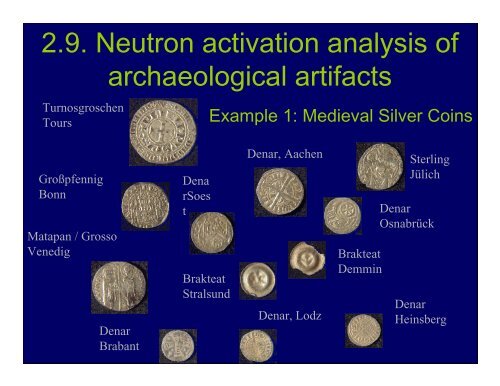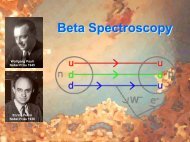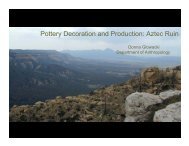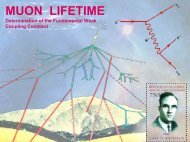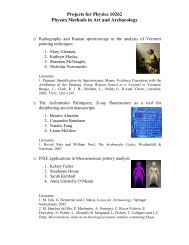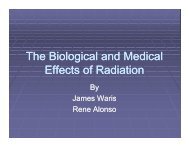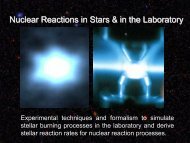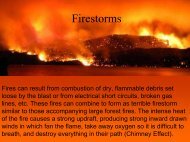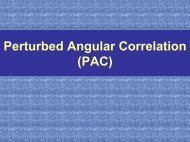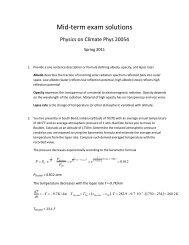2.9. Neutron activation analysis of archaeological artifacts
2.9. Neutron activation analysis of archaeological artifacts
2.9. Neutron activation analysis of archaeological artifacts
You also want an ePaper? Increase the reach of your titles
YUMPU automatically turns print PDFs into web optimized ePapers that Google loves.
<strong>2.9.</strong> <strong>Neutron</strong> <strong>activation</strong> <strong>analysis</strong> <strong>of</strong><br />
<strong>archaeological</strong> <strong>artifacts</strong><br />
Turnosgroschen<br />
Tours<br />
Example 1: Medieval Silver Coins<br />
Großpfennig<br />
Bonn<br />
Matapan / Grosso<br />
Venedig<br />
Denar<br />
Brabant<br />
Dena<br />
rSoes<br />
t<br />
Brakteat<br />
Stralsund<br />
Denar, Aachen<br />
Denar, Lodz<br />
Brakteat<br />
Demmin<br />
Sterling<br />
Jülich<br />
Denar<br />
Osnabrück<br />
Denar<br />
Heinsberg
Origin <strong>of</strong> silver coins
Accelerator based neutron source<br />
<strong>Neutron</strong>s can be produced by charged particle nuclear reactions:<br />
(p,n), (a,n), (g,n) at a wide range <strong>of</strong> energies (white neutron source)<br />
Reaction 7 Li(p,n) produces non-thermal neutron distribution<br />
p-beam<br />
n-cone<br />
7<br />
Li
<strong>Neutron</strong> <strong>activation</strong> with accelerators<br />
109<br />
Ag(n,γ) 110 Ag<br />
activity measurement:<br />
110<br />
Ag(β - ) 110 Cd<br />
(t 1/2 =250 d)<br />
Stable Silver isotope 109 Ag<br />
Stable Gold isotope 197 Au<br />
Determination<br />
<strong>of</strong> neutron flux<br />
197<br />
Au(n,γ) 198 Au<br />
activity measurement<br />
198<br />
Au(β-) 198 Cd<br />
(t 1/2<br />
=2.7 d)<br />
Copper<br />
Proton beam<br />
Lithium<br />
Au<br />
<strong>Neutron</strong>cone<br />
109<br />
Ag<br />
Additional measurement <strong>of</strong><br />
Cu and Au content in coin!<br />
<strong>Neutron</strong> source:<br />
7<br />
Li(p,n) 7 Be
<strong>Neutron</strong> spectrum<br />
Quasi-Maxwell-Distribution:<br />
kT = 25 keV<br />
E max = 110 keV<br />
Much higher than thermal<br />
reactor neutrons, kT=26 meV;<br />
the <strong>activation</strong> is not as efficient<br />
since the cross section is much<br />
lower (1/v law) – but well known!<br />
A thermalization <strong>of</strong> neutrons<br />
could be achieved by mounting<br />
paraffin blocks or some other<br />
thermalizing material with a high<br />
neutron scattering cross section.<br />
intensity<br />
measurement<br />
calc.neutron<br />
spectrum at<br />
kT = 25 keV<br />
neutron energy (keV)
Detection <strong>of</strong> characteristic γ-radiation<br />
70 mm<br />
2 Ge-Clover-detectors,<br />
with irridiated probe<br />
wedged in between<br />
Detection efficiency at<br />
1115 keV:<br />
Probe<br />
single crystal:<br />
η tot = 11 %<br />
η peak = 1.1 %<br />
detector array:<br />
η peak = 15 %
Characteristic γ spectrum<br />
after neutron <strong>activation</strong><br />
198<br />
Au<br />
412 keV<br />
110<br />
Ag<br />
658 keV<br />
64<br />
Cu<br />
1346 keV
Activity <strong>of</strong> Au and Ag contents<br />
109<br />
Ag(n,γ) 110 Ag T 1/2 ( 110 Ag)=250 d;<br />
λ Αg =1.16·10 -4 1/h<br />
E γ =658 keV<br />
197<br />
Au(n,γ) 198 Ag T 1/2 ( 198 Ag)=2.7 d;<br />
λ Αu =1.07·10 -2 1/h<br />
E γ =412 keV<br />
Activity after 2 hours <strong>of</strong> irradiation with 10 10 n/cm 2 s with<br />
σ Au =3mb and σ Ag =2mb<br />
A<br />
A<br />
Au<br />
Ag<br />
() t<br />
() t<br />
=<br />
I<br />
I<br />
Au<br />
Ag<br />
P<br />
P<br />
Au<br />
Ag<br />
⋅<br />
⋅<br />
() t<br />
() t<br />
−λ<br />
Au ⋅t<br />
( 1−<br />
e )<br />
⋅t<br />
Ag<br />
( 1−<br />
e )<br />
=<br />
−λ<br />
=<br />
σ<br />
σ<br />
Au<br />
Ag<br />
η( 412keV ) ⋅ AAu( t)<br />
η(<br />
658keV ) ⋅ A ( t)<br />
Ag<br />
−λ<br />
Au ⋅t<br />
⋅ N ⋅( 1−<br />
e )<br />
Au<br />
Ag<br />
⋅N<br />
⋅( 1−<br />
e )<br />
Ag<br />
−λ<br />
⋅t
Efficiency and Count Rate<br />
Efficiency η [%]<br />
10<br />
1.0<br />
η Au =0.5%=0.005<br />
η Ag =0.2%=0.002<br />
I ag = 6·10 5<br />
I au = 1·10 5<br />
0.1<br />
200 400 600 800 1000<br />
Energy [keV]<br />
N<br />
N<br />
Ag<br />
Au<br />
=<br />
σ<br />
σ<br />
Au<br />
Ag<br />
−λ<br />
Au ⋅t<br />
⋅( 1− e ) ⋅I<br />
⋅η<br />
−λ<br />
⋅t<br />
Ag<br />
Ag<br />
⋅( 1− e ) ⋅I<br />
⋅η<br />
Au<br />
Au<br />
Ag<br />
=<br />
191 . ⋅10<br />
928 . ⋅10<br />
−25<br />
−29<br />
≈<br />
210 ⋅<br />
3
Results for single coin<br />
measurements<br />
mass fraction %<br />
Silver<br />
Copper<br />
#12 shows mint<br />
deviations in Co,<br />
Ag, & Au content<br />
Gold<br />
Großpfennig,<br />
Bonn<br />
Coin
Comparison with <strong>of</strong>ficial mint<br />
statements<br />
Großpfennig,<br />
Bonn Bonn<br />
Previous Results<br />
1.part 16.century<br />
weight 1,30g<br />
Ag content 889/1000<br />
A weight 1,16g<br />
present Results<br />
weight 0,92g<br />
Ag content 977/1000<br />
Ag weight 0,90g<br />
2.part 16.century<br />
weight 1,33g<br />
Ag content 972/1000<br />
Ag weight 1,14g
Example 2: Qumran Pottery<br />
Provenance<br />
All clay sources on earth have a<br />
unique geochemical history, but<br />
show a slightly different impurity<br />
composition. Based on the<br />
<strong>analysis</strong> <strong>of</strong> these impurities the<br />
pottery can be traced to the site<br />
where it has been manufactured.<br />
Similarly, other <strong>artifacts</strong> made<br />
from pumice, obsidian glass,<br />
amber, basalt and sporadically<br />
flint can be traced to a distinctive<br />
source.<br />
Analysis <strong>of</strong> Qumran Pottery should establish the origin <strong>of</strong> the<br />
dead sea scroll containers and yield information on the cultural<br />
connection with other groups and villages
The Qumran Scrolls
Qumran site and samples<br />
Analysis <strong>of</strong> Qumran Pottery should establish the origin<br />
<strong>of</strong> dead sea scroll containers and yield information on<br />
the cultural connection with other groups and villages.<br />
Is there a difference between pottery found in the caves and at the Qumran site?<br />
Was the pottery made locally or was it imported?
Taking & Preparing a Sample<br />
A pottery sample is taken by grinding <strong>of</strong>f<br />
100 mg <strong>of</strong> ceramic resulting into a powder.<br />
This is then mixed with pure cellulose<br />
(50 mg) (as a binder) and pressed into a<br />
pellet <strong>of</strong> uniform size and thickness. The<br />
pellets--representing sherds or complete<br />
vessels--are wrapped in pure aluminum<br />
and set on edge into an aluminum capsule<br />
which is sent to a nuclear reactor where<br />
it is submitted to a neutron flux. Two or<br />
more samples <strong>of</strong> a standard <strong>of</strong> known chemical composition are<br />
added to the rest <strong>of</strong> the pellets.
<strong>Neutron</strong> <strong>activation</strong> with reactors
Activation procedure with thermal<br />
neutrons in reactor<br />
Cherenkov light<br />
Probe is positioned into neutron line
Activity measurements<br />
with a Ge-detector<br />
Gamma-ray spectrum showing several short-lived elements<br />
measured in a sample <strong>of</strong> pottery irradiated for 5 seconds, decayed<br />
for 25 minutes, and counted for 12 minutes with an HPGe detector.
Long-lived Isotopes<br />
Gamma-ray spectrum from 50 to 800 keV showing medium- and long-lived<br />
elements measured in a sample <strong>of</strong> pottery irradiated for 24 hours, decayed<br />
for 9 days, and counted for 30 minutes on a HPGe detector.
High energy γ-radiation<br />
Gamma-ray spectrum from 800 to 1600 keV showing medium- and long-lived<br />
elements measured in a sample <strong>of</strong> pottery irradiated for 24 hours, decayed<br />
for 9 days, and counted for 30 minutes on a HPGe dectector.
Gamma-ray Counts to Calculate<br />
Element Concentration<br />
To calculate the concentration (i.e., ppm <strong>of</strong> element) in the unknown sample it is<br />
irradiated together with a comparator standard containing a known amount <strong>of</strong><br />
the element <strong>of</strong> interest. If the unknown sample and the comparator standard are<br />
both measured on the same detector, one usually corrects the measured counts<br />
(or activity) for both samples back to the end <strong>of</strong> irradiation using the half-life <strong>of</strong><br />
the measured isotope. The equation used to calculate the mass <strong>of</strong> an element<br />
in the unknown sample relative to the comparator standard is<br />
where A= activity <strong>of</strong> the sample (sam) and standard (std), m= mass <strong>of</strong> the<br />
element, λ= decay constant for the isotope and t= decay time. For short<br />
irradiations, the irradiation, decay and counting times are the same for all<br />
samples and standards such that the time dependent factors cancel. Thus the<br />
above equation simplifies into<br />
where c= concentration <strong>of</strong> the element and W= weight <strong>of</strong> the sample and<br />
standard


